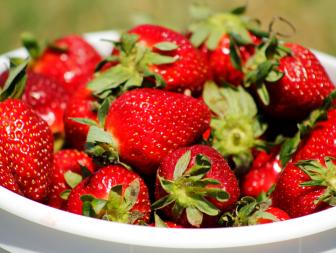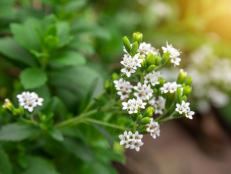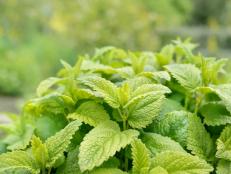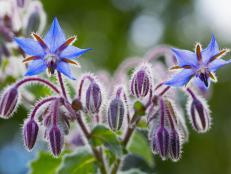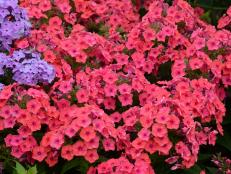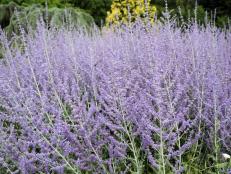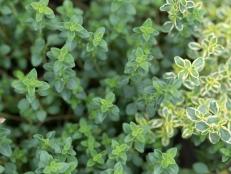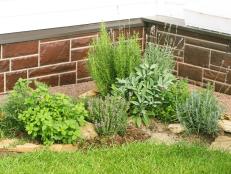How to Plant, Grow and Care for Chives
Learn how to plant, grow, harvest and use chives. This popular perennial herb is easy to grow and has many benefits in the kitchen as well as in the garden.

Chives are the delicately flavored, less onion-y herb in the onion family — Allium — that are used to enhance salads, soups, stews, eggs, vegetables and sauces. They are frost-hardy perennials in the herb bed, and once they’re established in the garden, you will have foot-high mounds of strappy, tender leaves for years. They grow in sun or part sun/shade, and in spring, the plants produce upright lavender-pink flowers that resemble clover blossoms.
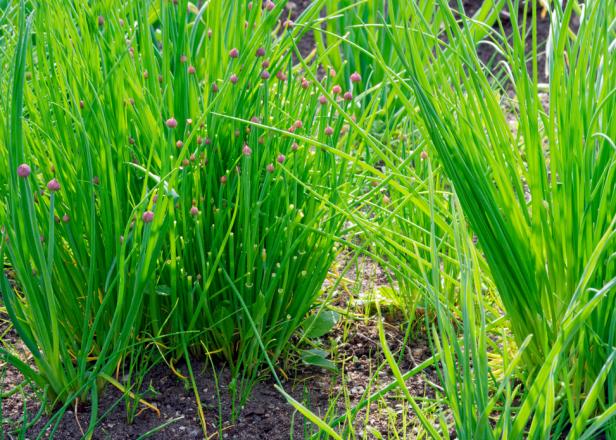
Shutterstock/Ad Oculos
Common chives (Allium schoenoprasum) are perennial plants that make a good addition to the early-spring garden. Purple buds bloom into globe-shaped flowers, and all parts of the plant are edible.
How to Plant Chives
Direct Sow Seeds
Common chives are easily grown from seeds sown in the garden in early spring. In a prepared bed of loose, fertile soil, sow clusters of seven to 10 seeds about 1/4 inch deep, spacing the clusters about 10 inches apart. Press the soil over the seeds, and keep the bed evenly moist. Seeds germinate about 14 to 21 days after planting; chive seedlings resemble grass-like stems when they emerge.
Transplants
Seeds can also be started indoors in late winter to set out in the garden in early spring. Six to 8 weeks before the average last frost date in your area, sow seven to 10 seeds 1/4 inch deep in individual containers of potting mix. They need a good light source to germinate, so place the planting tray in a sunny window or under grow lights, and keep the soil evenly moist. Plant the seedlings in a prepared garden bed when the clusters of seedlings are 2 to 3 inches tall.
Of course, you can buy already-started seedlings of chives at nurseries or garden centers in spring. In the garden, dig a hole in loose, fertile soil, knock the ball of roots out of its nursery pot and place it in the hole at the original soil depth, and fill in soil around the roots. Water the planting well, and keep the soil moist, but not soggy.
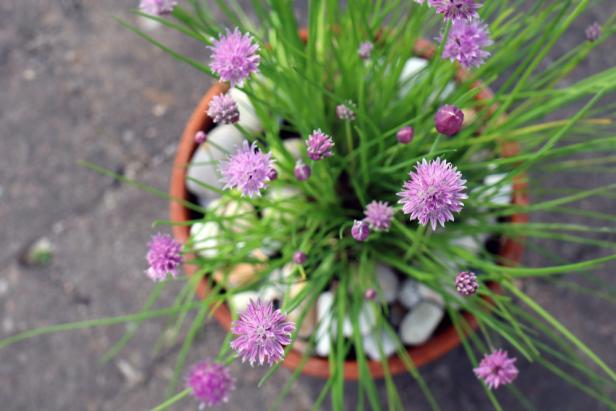
Shutterstock/Glimpse of Sweden
Chives grow well in containers outdoors in spring, summer and fall, and indoors in the winter where the weather is cold.
Chives also grow well in containers outdoors in spring, summer and fall, and indoors in the winter where the weather is cold. Plant seeds or starts from the nursery or from your garden in good potting mix in a pot that drains well, and keep the soil moist, but not wet. Chives growing indoors need plenty of light, so place the pot in a window that allows six to eight hours of sunlight, or place them under grow lights.
How to Care for Chives in the Garden
Once chives start to grow, they are pretty carefree plants. As long as they have good soil, sufficient water, enough space, and enough — but not too much — sun, they take care of themselves.
Problems that may occur in poor growing conditions can include spider mites or thrips that affect the foliage, or onion maggots that damage the roots. Use insecticidal soap to control pests on foliage.

Shutterstock/alfredhofer
You can harvest young chive leaves as soon as they are a good size by simply clipping them near the base of the plant with scissors or with a knife. Remove outer leaves first. Cutting the plant stimulates new growth.
A coating of gray spots on the foliage usually indicates powdery mildew. Yellow or brown spots may indicate Botrytis blight, which rots the plant from the center. Removing the diseased areas keeps the problems from spreading to the rest of the plants. To prevent over-crowding, divide established clumps of chives every three to four years in the spring.
Chives are relatively drought-tolerant, but yellow leaves may indicate that they haven’t gotten enough water. Yellow or drooping leaves may also indicate too much water or too much sun.
How to Harvest, Store and Use Chives
You can harvest young chive leaves as soon as they are a good size by simply clipping them with scissors. Chives are a cut-and-come-again herb, so snipping the leaves will stimulate new growth. Cut the leaves from the outside of the clump about a half-inch from the soil. Freshly cut chives can be stored in the refrigerator, wrapped in a paper towel and placed in a plastic bag, where they should last three to four days.
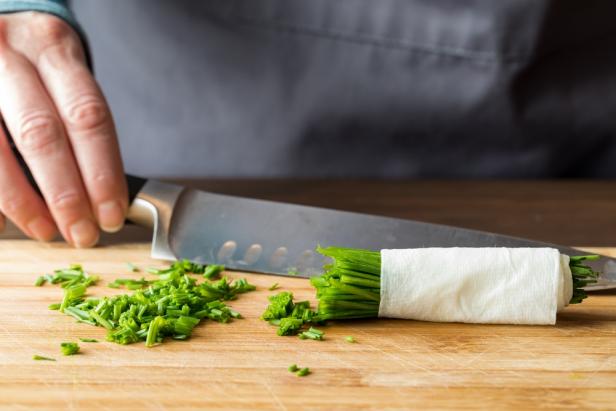
Shutterstock/Carey Jaman
In the kitchen, chives are one of the more versatile herbs. Use chive leaves and flowers in salads, make chive butter, oil or vinegar, use it on meat, fish and vegetables.
Chives can be frozen for longer storage. Spread the leaves on a baking sheet and pop them in the freezer. When the chives are frozen, store them in an airtight plastic bag or container and return to the freezer. You can also pack chopped chives into an ice cube tray, add a bit of water to each cube, and freeze. Store the frozen cubes in an airtight bag until you’re ready to use them.
Chives can also be air-dried. Wash freshly cut chives and let them dry on a paper towel, then tie strings tightly around bundles of cut chives and hang them in a warm, dry place. It may take several days, but they will be dry when they feel crisp and crackly. Store dried chives in an airtight jar.
All parts of the plant are edible, with a mild onion flavor. In the kitchen, chives are one of the more versatile herbs. Use chive leaves and flowers in salads, make chive butter, oil or vinegar, use it on meat, fish and vegetables. The flowers make an interesting statement in a spring arrangement, and both the flowers and the stems can be used as a pretty spring garnish.
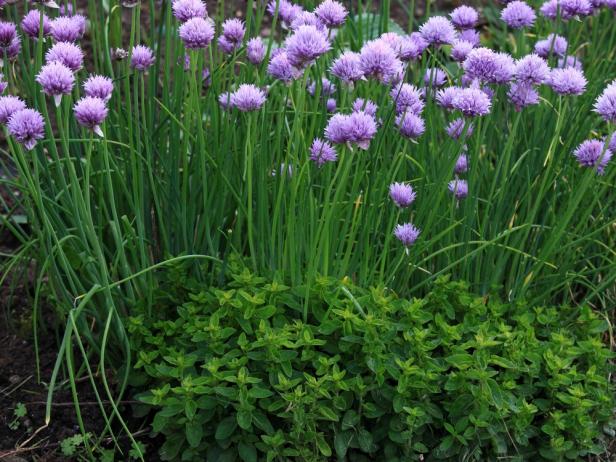
Shutterstock/iva
Chives are good companion plants with other herbs that require the same growing conditions, such as oregano.
Companion Planting With Chives
Common chives can be good companions to several other garden favorites for different reasons. They grow well alongside other Alliums — onions, garlic, scallions and leeks. Carrots and tomatoes also grow well with chives. Chives planted around apple trees are said to prevent apple scab. They add nutrients to the soil that benefit tomatoes, strawberries, lettuce and other garden favorites and, of course, other herbs that require the same growing conditions.
Don’t plant chives near asparagus, beans, peas or spinach, as it can stunt the growth of these vegetables.
A–Z Advice for Companion Planting in Your Vegetable Garden 16 Photos
Find detailed info and links for specific companion plants and planting techniques for popular vegetable garden crops in our alphabetical list, from beets to zucchini.
What are Garlic Chives?
Garlic chives must be chives that taste like garlic instead of onion, correct? Not exactly. It does resemble common chives but with a mild garlic flavor, but it’s a different species of Allium — A. tuberosum.
While common chives (A. schoenoprasum) have hollow, tubular leaves, garlic chives’ leaves are flatter, and the flowers, which bloom later than common chives, are white instead of lavender-pink. Common chives spread by dropping seeds to the ground after they flower; garlic chives spread by self-seeding, too, but also by rhizomes. Garden experts warn that they can become invasive.
Garlic chives are native to southeastern Asia; another name for them is Chinese chives. They are a common ingredient in Asian cuisine. The leaves and flowers are used for cooking, but the bulb of garlic chive is not edible.
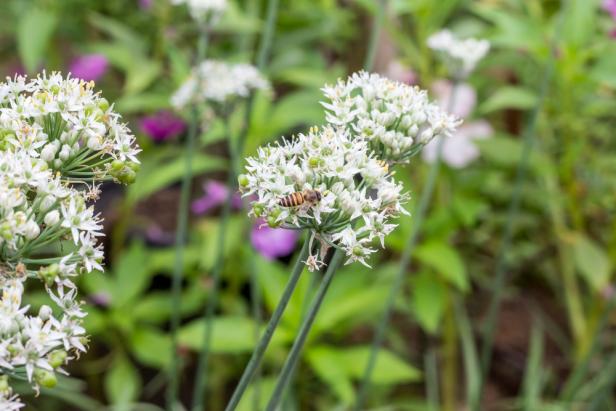
Shutterstock/amnuai1993
The leaves and flowers of garlic chives have a mild onion flavor. The white flowers attract bees and other beneficial pollinator insects.
More Reasons to Grow Chives
When they flower in spring, the lavender-pink blooms of common chives attract butterflies, hummingbirds and beneficial pollinators. Their pungent odor has a different effect on other wildlife: it may repel some garden pests, such as aphids, cucumber beetles and Japanese beetles, and has been known to keep rabbits and deer away from garden beds.
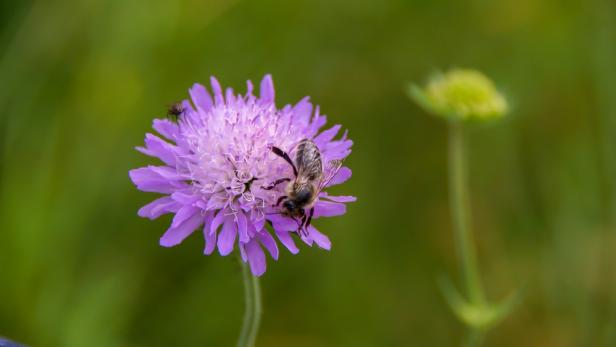
Shutterstock/aaddyy
When they flower in spring, the lavender/pink blooms of common chives attract honeybees and other pollinators, as well as butterflies and hummingbirds.
How to Plant a Kitchen Herb Garden
Herbs are easy to grow, they don’t take up a lot of space and they are a healthy way to add more flavor to your cooking. Whether you’re a beginning gardener or looking to elevate your culinary skills, an herb garden is the way to go.
Can You Freeze It? 35 Photos
Find out how to freeze fruits and vegetables such as bananas, watermelon, apples and avocados as well as some surprising things you maybe didn't know you could freeze like eggs and milk.

.-Battle-on-the-Beach-courtesy-of-HGTV.-.jpg.rend.hgtvcom.196.196.suffix/1714761529029.jpeg)






